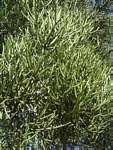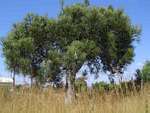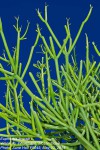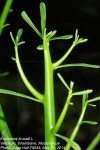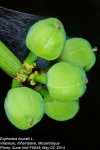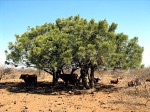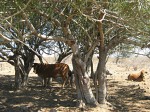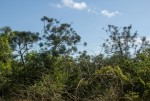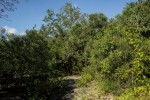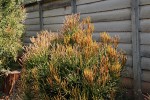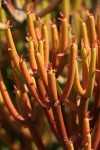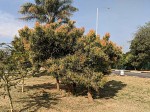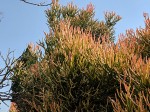Euphorbia tirucalli
Selected images: Click on each image to see a larger version and details of the record View all images (15)
Detailed records: Display species records QDS maps by: Google Maps Point records by Google Maps
Species details: Click on each item to see an explanation of that item (Note: opens a new window)
| Synonyms: |
Euphorbia media N.E. Br. Euphorbia media N.E. Br. var. bagshawei N.E. Br. Euphorbia rhipsaloides N.E. Br. Euphorbia scoparia N.E. Br. |
| Common names: | Pencil cactus (English) Rubber euphorbia (English) Rubber hedge plant (English) |
| Frequency: | |
| Status: | Probably introduced, but a frequent relic of cultivation and sometimes naturalised. |
| Description: |
Unarmed, succulent shrub to 5 m, or a small tree to 12 m, with brittle succulent branches which are often whorled, c.7 mm thick, green with fine longitudinal white striations. Leaves few, linear-lanceolate to narrowly obovate, fleshy, present only on new growth and quickly deciduous. Cymes 2-6, congested at apices of branchlets, forking 2-4-times, producing cyathia, these usually either all male or all female. Cyathium c.3 × 4 mm; glands to 1.5 × 2 mm, 5, subspherical to transversely elliptic, bright yellow; lobes c.0.5 mm, triangular. Capsule c.8 × 8.5 mm, subspherical, glabrescent, exserted on a tomentose pedicel. Seeds 3.5 × 2.8 mm, ovoid, smooth. |
| Type location: |
Lectotype from Sri Lanka |
| Notes: | |
| Derivation of specific name: | tirucalli: from a name used by the inhabitants of Malabar, a region of southern India. |
| Habitat: | Open woodland; very frequently planted and naturalising near habitation. |
| Altitude range: (metres) | |
| Flowering time: | Oct - Dec |
| Worldwide distribution: | Widespread in tropical Africa, the Arabian Peninsula, Madagascar, India and the Far East. |
| Growth form(s): | Tree, shrub over 2 m, shrub under 2 m. |
| Endemic status: | |
| Red data list status: | |
| Insects associated with this species: | |
| Spot characters: | Display spot characters for this species |
| Literature: |
Burrows, J.E., Burrows, S.M., Lötter, M.C. & Schmidt, E. (2018). Trees and Shrubs Mozambique Publishing Print Matters (Pty), Cape Town. Page 456. (Includes a picture). Carter, S. & Leach, L.C. (2001). Euphorbiaceae: subfamily Euphorbioideae: tribe Euphorbieae Flora Zambesiaca 9(5) Pages 391 - 392. Curtis, B.A. & Mannheimer, C.A. (2005). Tree Atlas of Namibia National Botanic Research Institute, Windhoek Page 639. Drummond, R.B. (1975). A list of trees, shrubs and woody climbers indigenous or naturalised in Rhodesia. Kirkia 10(1) Page 253. Heath, A. & Heath, R. (2009). Field Guide to the Plants of Northern Botswana including the Okavango Delta Kew Publishing Page 90. (Includes a picture). Mapaura, A. & Timberlake, J. (eds) (2004). A checklist of Zimbabwean vascular plants Southern African Botanical Diversity Network Report No. 33 Sabonet, Pretoria and Harare Page 41. Ntore, S. & al. (2024). Checklist of the vascular plants of Burundi Page 109. Parker, T. (2023). Common Trees of Mozambique The Tree Press, Austin, Texas, USA Pages 142 - 143. (Includes a picture). Setshogo, M.P. (2005). Preliminary checklist of the plants of Botswana. Sabonet Report no. 37. Sabonet, Pretoria and Gaborone Page 57. Siebert, S. & Mössmer, M. (Editors) (2002). SABONET Southern Mozambique Expedition 2001; Provisional Plant Checklist of the Maputo Elephant Reserve (MER) and Licuati Forest Reserve (LFR) SABONET News 7(1) Page 25. |
Other sources of information about Euphorbia tirucalli:
Our websites:
Flora of Botswana: Euphorbia tirucalliFlora of Botswana: cultivated Euphorbia tirucalli
Flora of Burundi: Euphorbia tirucalli
Flora of Malawi: Euphorbia tirucalli
Flora of Mozambique: Euphorbia tirucalli
Flora of Mozambique: cultivated Euphorbia tirucalli
Flora of Zambia: Euphorbia tirucalli
Flora of Zimbabwe: Euphorbia tirucalli
Flora of Zimbabwe: cultivated Euphorbia tirucalli
External websites:
African Plants: A Photo Guide (Senckenberg): Euphorbia tirucalliAfrican Plant Database: Euphorbia tirucalli
BHL (Biodiversity Heritage Library): Euphorbia tirucalli
EOL (Encyclopedia of Life): Euphorbia tirucalli
GBIF (Global Biodiversity Information Facility): Euphorbia tirucalli
Google: Web - Images - Scholar
iNaturalist: Euphorbia tirucalli
IPNI (International Plant Names Index): Euphorbia tirucalli
JSTOR Plant Science: Euphorbia tirucalli
Mansfeld World Database of Agricultural and Horticultural Crops: Euphorbia tirucalli
Plants of the World Online: Euphorbia tirucalli
Tropicos: Euphorbia tirucalli
Wikipedia: Euphorbia tirucalli
